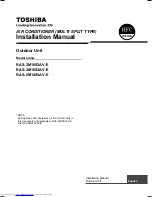
8
Installation Manual
Outdoor Unit
6
Refrigerant piping
CAUTION
Install in rooms that are 5 m
3
or larger. If
a leak of refrigerant gas occurs inside the
room, an oxygen de
fi
ciency may occur.
■
Detaching the Valve cover
Remove the 5 screws.
• Pull the valve cover in the direction of the arrow, and remove it.
Valve cover
■
Refrigerant Piping Connection
Flaring
1. Cut the pipe with a pipe cutter.
Obliquity
Roughness
Warp
90°
2. Remove the burr inside of the pipe.
When removing the burr, be careful so that chips do not fall into the pipe.
3. Remove the
fl
are nuts attached to the outdoor/indoor unit, then insert them
into each of the pipes.
4. Flare the pipes.
See the following table for the projection margin (A) and
fl
aring size (B).
Die
Pipe
B
A
Pipe
A
B
Flare Nut
Outside
diameter
Thickness
Rigid
(clutch
type)
R410A
tool
Imperial
(wing
nut type)
R410A
tool
Width
across
flat
Tighten
torque
mm
mm
mm
mm
mm
mm
N•m
kgf•m
6.35
0.8
0 to 0.5
1.5 to
2.0
9.1
17
14 to
18
1.4 to
1.8
9.52
0.8
0 to 0.5
1.5 to
2.0
13.2
22
33 to
42
3.3 to
4.2
12.7
0.8
0 to 0.5
2.0 to
2.5
16.6
26
50 to
62
5.0 to
6.2
Pipe connection
1. Make wire and pipe connections for each indoor unit separately.
2. Align the centres of the connecting pipes and tighten the
fl
are nut as much
as possible with your
fi
ngers, then tighten the nut using a torque wrench.
Be sure to tighten the nut at the speci
fi
ed torque value.
• If you use one outdoor unit for several indoor units of a different class,
connect the largest one
fi
rst A, then connect the rest in the order B to C.
• Do not remove the
fl
are nuts for any ports you are not going to use for
connection.
• Do not leave the
fl
are nut unattached for a long period of time.
• Use a different-diameter joint if the diameters of the connection port and
connection piping are different.
• Mount the different-diameter joint on the connection port of the outdoor
unit.
■
Air Purge
From the sake of environmental protection, use a vacuum pump to extract
the air during installation.
* Prepare a 4 mm hexagon wrench.
1. Connect a charge hose.
• Make sure that the Handle Hi of the gauge manifold valve is closed fully.
• Connect the port of the gauge manifold valve and the service port (Valve
core (Setting Pin)) using the charge hose.
NOTE
If a control valve or charge valve is attached to the charge hose, leak
of R410A refrigerant can be avoided.
2. Open the Handle Low of the gauge manifold valve fully, then operate the
vacuum pump.
• Loosen the
fl
are nut of the at the gas end a little to make sure that air is
taken in, then tighten the nut.
• If you
fi
nd air is not taken in, make sure that the charge hose is
connected to the port(s) securely.
• Perform extraction for about 15 or more minutes and make sure that the
compound pressure gauge reading is –101 kPa (–76 cmHg).
• If the compound pressure gauge reading is not –101 kPa (–76 cmHg),
there is a possibility air is being taken in from the port(s).
• Make sure that the charge hose is connected to the port(s) securely.
3. Close the Handle Low of the gauge manifold valve fully, then stop
operating the vacuum pump.
• Leave the gauge and pump as they are for 1 or 2 minutes, then make
sure that the compound pressure gauge reading stays at –101 kPa
(–76 cmHg).
• You need not add refrigerant.
4. Disconnect the charge hose from the service port, then open the valve
stem fully using a 4 mm hexagon wrench.
Hexagon wrench is
required.
Service port cap
Valve stem cap
4 mm
5. Tighten the service valve stem cap and service port cap securely.
CAUTION
Use a torque wrench and tighten the nut at
the speci
fi
ed torque value.
6. Tighten all the caps on the valves securely, then perform a gas leak
inspection.
Service valve
Tighten torque
Valve stem cap
Service port cap
Type
mm
N•m
kgf•m
N•m
kgf•m
Liquid side
6.35
14 to 18
1.4 to 1.8
—
—
Gas side
9.52
14 to 18
1.4 to 1.8
14 to 18
1.4 to 1.8
12.7
33 to 42
3.3 to 4.2
14 to 18
1.4 to 1.8
Service valve at
the liquid side
Service valve at
the gas side
Service port
(Valve core
(Setting pin))
Vacuum pump
Handle Hi
(Keep full closed)
Pressure gauge
Manifold valve
Charge hose
(For R410A only)
Vacuum pump
adapter for counter-
flow preventation
(For R410A only)
Charge hose
(For R410A only)
Compound
pressure gauge
–101 kPa (–76 cmHg)
Handle Low
1116691099_(01) EN.indd 8
1116691099_(01) EN.indd 8
9/22/15 5:59 PM
9/22/15 5:59 PM
































